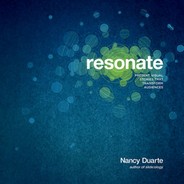40 Resonate
The middle of a presentation is made up of various
types of contrast. People are naturally drawn to
contrast because life is surrounded by it. Day and
night. Male and female. Up and down. Good and evil.
Love and hate.
Your job as a communicator is to create and resolve
tension through contrast.
Building highly contrasting elements into a presenta-
tion holds the audience’s attention. Audiences enjoy
experiencing a dilemma and its resolution—even if that
dilemma is caused by a viewpoint that’s opposed to
their own. It keeps them interested.
The audience wants to know if your views are similar
to or different from their views. While listening to a
presenter, audience members catalog and classify what
they hear. Having come into the room with their own
knowledge, and biases, they are constantly evaluating
whether what you say fits within their life experiences
or falls outside of what they know.
It’s important to know your audience so that you can
understand how your views are both similar to and dif-
ferent from theirs. There will usually be some disparities.
A rather obvious business example would be that you
want them to buy your product, and they don’t want to
spend the money.
But differences aren’t a problem. The polarity between
similar and dissimilar concepts creates a force that can
be put to good use. In fact, both extremes are necessary
The Middle: Contrast
in a presentation. They allow you to create observ-
able distinctions between your perspectives and your
audience’s perspectives—this helps keep their attention.
Though people are generally more comfortable with
what’s familiar to them, conveying the opposite creates
internal tension. Oppositional content is stimulating;
familiar content is comforting. Together, these two
types of content produce forward movement.
There are three distinct types of contrast you can build
into a presentation:
Content:• Content contrast moves back and forth to
compare what is to what could be—and your views
versus the audience’s (pages 104 to 105).
Emotion:• Emotional contrast moves back and forth
between analytical and emotional content (pages
136 to 137).
Delivery:• Delivery contrast moves back and forth
between traditional and nontraditional delivery
methods (pages 138 to 139).
Contrast is a motif woven throughout this entire book
and is at the heart of communication, because people
are attracted to things that stand out.
“As the polarized nature of magnetic fields can be
used to generate electrical energy, polarity in a story
seems to be an engine that generates tension and
movement in the characters and a stirring of emo-
tions in the audience.”
Chris Vogler
11
CH002.indd 40CH002.indd 40 8/16/10 9:01:13 AM8/16/10 9:01:13 AM

Lessons from Myths and Movies 41
CH002.indd 41CH002.indd 41 8/16/10 9:01:13 AM8/16/10 9:01:13 AM
..................Content has been hidden....................
You can't read the all page of ebook, please click here login for view all page.
